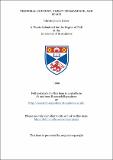Files in this item
Temporal context, object permanence, and space
Item metadata
| dc.contributor.advisor | Perrett, David | |
| dc.contributor.author | Baker, Christopher I. | |
| dc.coverage.spatial | 300 p. | en_US |
| dc.date.accessioned | 2018-06-26T10:17:21Z | |
| dc.date.available | 2018-06-26T10:17:21Z | |
| dc.date.issued | 1999 | |
| dc.identifier.uri | https://hdl.handle.net/10023/14592 | |
| dc.description.abstract | In everyday life objects are continually moving into and out of view, yet we experience a stable environment in which objects are "permanent" and have an existence independent of observation. Many non-human species also exhibit such "object permanence", although the nature of their representations of occluded objects remains unclear. This thesis investigated knowledge and representation of occluded objects in Rhesus macaques (Macaca mulatto). At the behavioural level, an analysis of the reaching behaviour of a macaque demonstrated representation for the motivational value of rewards hidden from sight, and provided some evidence for the representation of object form. At the neural level, a population of cells was found in the superior temporal sulcus of macaques that might contribute to object permanence. The cells showed prolonged responses as objects moved gradually out of sight behind occluding screens. This activity was selective for the location of occlusion and did not develop fully until complete occlusion of the object. A small population of bimodal (auditory-visual) cells showed related activity with modulation of response to an auditory stimulus dependent on whether the sound source was in or out of sight. An influence of the position of the stimuli was also observed for these cells. An analysis of cells with diverse response characteristic revealed that positional sensitivity was not limited to a small sub-group of cells within the superior temporal sulcus. This is the first evidence for spatial coding in temporal cortex, a region associated with object recognition. Keywords: object permanence, macaque, STS, multisensory integration, occlusion, spatial coding, dorsal and ventral streams. | en_US |
| dc.language.iso | en | en_US |
| dc.publisher | University of St Andrews | |
| dc.subject.lcc | QP492.B2 | en |
| dc.subject.lcsh | Form, solidity, size | en |
| dc.title | Temporal context, object permanence, and space | en_US |
| dc.type | Thesis | en_US |
| dc.contributor.sponsor | University of St Andrews | en_US |
| dc.type.qualificationlevel | Doctoral | en_US |
| dc.type.qualificationname | PhD Doctor of Philosophy | en_US |
| dc.publisher.institution | The University of St Andrews | en_US |
This item appears in the following Collection(s)
Items in the St Andrews Research Repository are protected by copyright, with all rights reserved, unless otherwise indicated.

